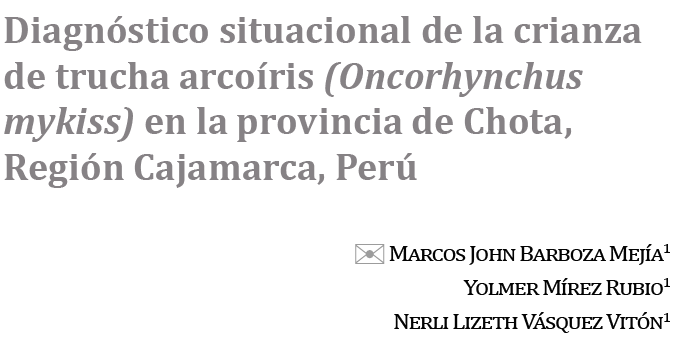Español Situational diagnosis of rainbow trout (Oncorhynchus mykiss) farming in the province of Chota, Cajamarca Region, Peru
Diagnóstico situacional de la crianza de trucha arcoíris (Oncorhynchus mykiss) en la provincia de Chota, Región Cajamarca, Perú


This work is licensed under a Creative Commons Attribution-NonCommercial-NoDerivatives 4.0 International License.
Copyright statement
The authors exclusively assign to the Universidad EIA, with the power to assign to third parties, all the exploitation rights that derive from the works that are accepted for publication in the Revista EIA, as well as in any product derived from it and, in in particular, those of reproduction, distribution, public communication (including interactive making available) and transformation (including adaptation, modification and, where appropriate, translation), for all types of exploitation (by way of example and not limitation : in paper, electronic, online, computer or audiovisual format, as well as in any other format, even for promotional or advertising purposes and / or for the production of derivative products), for a worldwide territorial scope and for the entire duration of the rights provided for in the current published text of the Intellectual Property Law. This assignment will be made by the authors without the right to any type of remuneration or compensation.
Consequently, the author may not publish or disseminate the works that are selected for publication in the Revista EIA, neither totally nor partially, nor authorize their publication to third parties, without the prior express authorization, requested and granted in writing, from the Univeridad EIA.
Show authors biography
The objective of the study was to carry out a situational diagnosis of rainbow trout in the province of Chota, Cajamarca Region. Eighty percent of producers (n=12) were interviewed by means of a survey between November and December 2021. Ninety-two percent of the respondents were male and the majority had completed secondary education. The main activities developed by the producers are trout farming (67%), agriculture and livestock (33%). More than 50% of the farmers dedicated 5 hours to fish farming, and the trout were raised in concrete ponds. The water supply to the production center comes from the rivers. Nearly 50% of the producers stated that they purchase embryonated eggs from the U.S. The production time ranges from 5 to 6 months. The greatest mortality episodes occur during the dry season and are attributed to oxygen deficiency and water temperature. Ninety-two percent of producers use commercial feed and most feed three times a day without measuring water temperature. The weight of trout for sale ranges from 200 to 250 g and they are sold whole at a price of 15 to 18 soles.
Article visits 817 | PDF visits 757
Downloads
- Becker, J. A., Speare, D. J., y Dohoo, I. R. (2005). Influence of feeding ratio and size on susceptibility to microsporidial gill disease caused by Loma salmonae in rainbow trout, Oncorhynchus mykiss (Walbaum). Journal of Fish Diseases, 28(3), 173–180. https://doi.org/10.1111/j.1365-2761.2005.00614.x
- Bermudes, D. (2015). Desinfección solar para el abastecimiento de agua de consumo humano a nivel domiciliario en el sector de la Pereira, Parroquia la Avanzada, Cantón Santa Rosa, Provincia de el Oro (Tesis de pregrado). Universidad Técnica de Machala.
- Dirección de la Sub Región de la Producción – DISUREPRO. (2021). Manual de crianza de trucha. Informe anual de pesca. Acuicultura.
- Cazorla J. (2011). Manual de buenas prácticas en truchicultura ecológicamente sostenible. Puno.
- Chaves-Rojas, R., y Vargas-Cordero, R. (2016). Diferentes densidades de carga en trucha arcoíris mediante análisis de parámetros económicos y biológicos. Nutrición Animal Tropical, 10(2). 38 – 60. http://dx.doi.org/10.15517/nat.v10i2.26112
- Fondo Nacional de Desarrollo Pesquero – FONDEPES. (2021). Manual de crianza de trucha en ambientes convencionales. Lima.
- Fondo Nacional de Desarrollo Pesquero – FONDEPES. (2020). Informe de la Subdirección de Sanidad Acuícola. Lima.
- Fondo Nacional de desarrollo Pesquero-FONDEPES. (2014). Manual de crianza de truchas en ambientes convencionales. Lima.
- García-Mondragón, D., Gallego-Alarcón, I., Espinoza-Ortega, A., García-Martínez, A. y Arriaga-Jordán, C. M. (2013). Desarrollo de la producción de trucha arcoíris (Oncorhynchus mykiss) en el Centro de México. AguaTIC, (38), 46-56.
- Gatlin, D. M., Barrows, F. T., Brown, P., Dabrowski, K., Gaylord, T. G., Hardy, R. W., Herman, E., Hu, G., Krogdahl, A., Nelson, R., Overturt, K., Rust, M., Sealey, W., Skonberg, D., Souza, E. J., Stone, D., Wilson, R. y Wurtele, E. (2007). Expanding the utilization of sustainable plant products in aquafeeds: a review. Aguaculture Research, 38(6), 551-579. https://doi.org/10.1111/j.1365-2109.2007.01704.x
- Greene, J., y Grizzle, R. (2007). Successional development of fouling communities on open ocean aquacultu.re fish cages in the western Gulf of Maine, USA. Aquaculture, 262(2-4), 289-301. https://doi.org/10.1016/j.aquaculture.2006.11.003
- Hernández, L. y Fernández, M. (2013). Fuentes de proteína alternativas para dietas de trucha arcoíris (Oncorhynchus mykiss). Avances en Nutrición Acuícola. 49-65.
- Maraví, J. (2013). Parámetros productivos en alevinos de trucha arcoíris, procedentes de ovas nacionales e importadas en la piscigranja Gruta Milagrosa – Acopalca – Huancayo (Tesis de pregrado). Universidad Nacional del Centro del Perú, Huancayo.
- Mendoza, D. (2015). Consultoría sobre el rol de la mujer en los sectores de la pesca y acuicultura en el Perú.
- Ministerio de la Producción. (2019). Situación actual de la acuicultura en el Perú.
- Poma, J. (2013). Evaluación productiva y económica de alevinos de trucha arcoíris (Oncorhynchus mykiss), en la piscigranja “Gruta Milagrosa” – Acopalca – Huancayo (Tesis de pregrado). Universidad Nacional del Centro del Perú – Huancayo.
- Organización Mundial de Sanidad Animal. (2017). Código sanitario para animales acuáticos. Capítulo 4.3. Desinfección de establecimientos y equipos de acuicultura.
- Yunis, J., Anicama, J., Manchego, A., y Nieves, C. (2015). Presencia de Piscirickettsia salmonis en Truchas de Cultivo (Oncorhynchus mykiss) en Junín, Perú. Revista de investigaciones Veterinarias del Perú, 26(1), 140-145. https://doi.org/10.15381/rivep.v26i1.10922
- Zárate, I., Sánchez, C., Palomino, H. y Smith, C. (2018). Caracterización de la crianza de trucha arcoíris (Oncorhynchus mykiss) en la provincia de Chincheros, Apurímac, Perú. Revista de Investigaciones Veterinarias del Perú. 29(4), 1310-1314. https://doi.org/10.15381/rivep.v29i4.15196




